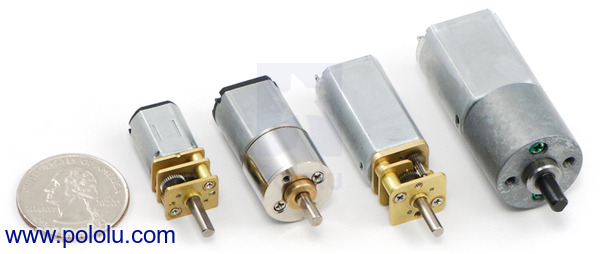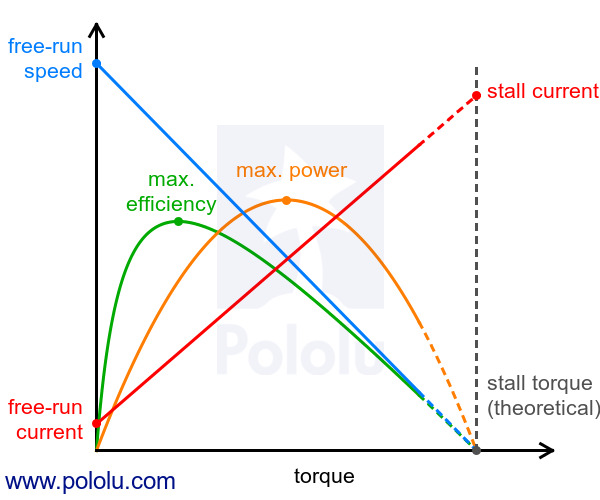These small brushed DC gearmotors can deliver a lot of power for their size. This version has a 154:1 metal gearbox with a 0.276"-long, 4 mm-diameter D-shaped output shaft. Key specs at 6 V: 90 RPM and 250 mA free-run, 120 oz-in (8.6 kg-cm) and 3.3 A stall.
The 20D mm line of brushed DC gearmotors all have the same dimensions except for the length of the gearbox, and they are intended for use at 6 V. In general, these kinds of motors can run at voltages above and below this nominal voltage, so they should comfortably operate in the 3 – 9 V range. Higher voltages could start negatively affecting the life of the motor, and lower voltages might not be practical. Four different gear ratios are available:
| Gear Ratio | No-Load Speed @ 6 V |
No-Load Current @ 6 V |
Stall Torque @ 6 V |
Stall Current @ 6 V |
|---|---|---|---|---|
| 29:1 | 450 RPM | 250 mA | 25 oz-in | 3.3 A |
| 56:1 | 250 RPM | 250 mA | 45 oz-in | 3.3 A |
| 73:1 | 180 RPM | 250 mA | 60 oz-in | 3.3 A |
| 154:1 | 90 RPM | 250 mA | 120 oz-in | 3.3 A |
Note: Stalling gearmotors can greatly decrease their lifetimes, occasionally resulting in immediate damage to the gearbox. This is especially true for the higher gear ratios, which can generate enough torque to damage themselves. Prolonged stalls (on the order of seconds) can result in thermal damage to the motor windings and brushes.
The gearmotor face plate has two mounting holes threaded for M2.5 screws, and you can use our custom-designed 20D mm metal gearmotor bracket (shown in the left picture below) to mount the gearmotor to your project via these mounting holes and the screws that come with the bracket.
This gearmotor has an output shaft with a diameter of 4 mm; the Pololu universal aluminium mounting hubs for 4mm shafts can be used to mount our larger Pololu wheels (60mm-, 70mm-, 80mm-, and 90mm-diameter) or custom wheels and mechanisms to the gearmotor’s output shaft (see the right picture above). Alternatively, you could use our 4mm scooter wheel adaptor to mount many common scooter, skateboard, and inline skate wheels to the gearmotor’s output shaft, and you can use our 12mm hex wheel adaptor to use this motor with many common hobby RC wheels. The gearbox’s output shaft also works directly with the 120mm-diameter Wild Thumper wheels, as shown below.
The diagram below shows the dimensions of the 25D mm line of gearmotors (units are mm over [inches]). This diagram is also available as a downloadable PDF (172k pdf).
This diagram is also available as a downloadable PDF (172k pdf).
We offer a wide selection of metal gearmotors that offer different combinations of speed and torque. Our metal gearmotor comparison table can help you find the motor that best meets your project’s requirements.
 |
| Some of the Pololu metal gearmotors. |
|---|
| Size: | 20D x 47L mm |
|---|---|
| Weight: | 44 g |
| Shaft diameter: | 4 mm |
| Gear ratio: | 154:1 |
|---|---|
| Free-run speed @ 6V: | 90 rpm |
| Free-run current @ 6V: | 250 mA |
| Stall current @ 6V: | 3300 mA |
| Stall torque @ 6V: | 120 oz·in |
No; the information we have available for this motor can be found on its product page. However, you can approximate various additional motor parameters from the information found in the “Specs” tab.
The electrical resistance of the motor can be approximated by dividing the rated voltage by the stall current (at the rated voltage). The electromotive force constant (Ke) can be approximated by dividing the rated voltage by the free-run speed (at the rated voltage). To approximate the motor torque constant (Kt), you can divide the stall torque by the stall current.
For pretty much any DC motor, the current, speed, power, and efficiency curves as a function of torque will look like those in the graph below (assuming motor voltage and temperature are constant):
 |
The current and speed curves are approximately linear, and the product pages for our motors provide the approximate end points for these lines: (0 torque, no-load current) and (stall torque, stall current) for the red line, and (0 torque, no-load speed) and (stall torque, 0 speed) for the blue line.
The orange output power curve is the product of the speed and the torque, which results in an inverted parabola with its peak at 50% of the stall torque.
The green efficiency curve is the output power divided by the input power, where the input power is current times voltage. The voltage is constant, so you can divide the output power curve by the current line to get the general shape of the efficiency curve, which in turn lets you identify the torque, speed, and current that correspond to max efficiency.
There are many programs out there that you can use to generate these curves. For example, if you have access to MATLAB, you can use this customer-created MATLAB script to generate these motor plots for you from the specifications we provide for each gearmotor.
Note: A good general rule of thumb is to keep the continuous load on a DC motor from exceeding approximately 20% to 30% of the stall torque. Stalling gearmotors can greatly decrease their lifetimes, occasionally resulting in immediate damage to the gearbox or thermal damage to the motor windings or brushes. Do not expect to be able to safely operate a brushed DC gearmotor all the way to stall. The safe operating range will depend on the specifics of the gearmotor itself.